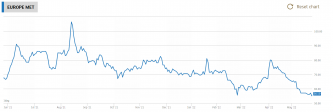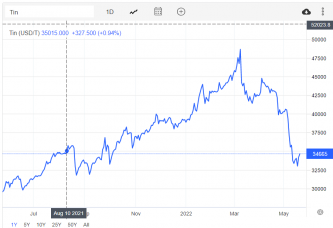Key points:
- The European Metals share price seems influenced by the falling tin price
- As European Metals intends to be a tin miner this seems reasonable
- That influence of the tin price is likely to continue
European Metals (LON: EMH) shares are down over the past couple of months. The geologic prospects for the company haven't changed, there's been no significant legislative or licencing change affecting them. So, why has the share price declined from 80 pence to 55 pence today?
A simple answer is just to look at these two charts:

And then this one:

We can see, rather clearly, that the European Metals share price is following the tin price down. Given that European Metals has the rights to the Cinovec tin deposit – one of Europe's largest hard rock tin deposits – this seems reasonable enough.
Also Read: The Best Lithium and Lithium Mining Stocks to Buy
Yet European Metals says it's both a lithium and a tin miner, doesn't the soaring lithium price make up for this? Well, yes and no, for two different reasons.
The first reason is the geology of that Cinovec deposit. There is indeed both tin and lithium in there. It's entirely possible to co-extract too. But as we've seen at Zinnwald Lithium (Zinnwald is the German village metres away from Cinovec on the Czech side of the border, the deposits are really pretty much the same place) there's a complication in the extraction of the lithium. It's contained within a mica called zinnwaldite and a new process to extract is required. Now, it's said that this has been done and works, but it still has;t been deployed at industrial scale so there's still a tinge of uncertainty about that. The chemistry works, but the economics?
Of course, at current lithium prices it works economically, but that's not the calculation. Will it work at the lithium market prices when the two mines – Zinnwald and Cinovec – come to market? There's, let us say, some uncertainty about that. How much uncertainty is up to each of us to decide.
The other reason is that Cinovec really is one of Europe's largest hard rock tin deposits. Which means that, as with First Tin (which is working on the other end of the same geology, further SW in the Erzgebirge), the future value of the mine depends upon the value of that major product, the tin.
The EV revolution is going to require much more tin, that's true and obvious. So will the electrification of household heating and so on – solder is indeed made of tin, more electrification requires more tin. But as so often happens when a mineral price rises more people go looking in more places for that mineral. So many more look so much more that we end up finding much more than we thought was out there. As the economists like to say, the cure for high prices is high prices – more production comes online as a result of those extra profits.
The result of this is that miners often do fall back. Because the very high prices that led to investment in this tin miner have also led to investment in many other tin miners – there's more tin around and so a lower price.
European Metals is still some years away from production, even if it does come online. A reasonable thought is that in the absence of development new than the European Metals share price will be heavily influenced by the tin price.




